Turkey Travel Journal: Central Anatolia
| This travel journal is part of a series of journals, which are all written during a long trip between november 2007 and may 2009. |
> To Afyon
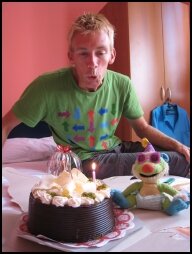 15-08-2008 After a week at the beach and seeing some cultural sights at the Northern Aegean Sea we celebrated Peters birthday in Istanbul yesterday, where we also started our trip with Peters parents. This morning each of us went their own way: they flew back to Holland after slightly more than two weeks, we got into the bus to Afyon.
15-08-2008 After a week at the beach and seeing some cultural sights at the Northern Aegean Sea we celebrated Peters birthday in Istanbul yesterday, where we also started our trip with Peters parents. This morning each of us went their own way: they flew back to Holland after slightly more than two weeks, we got into the bus to Afyon.Bus trips are something we can't get used to in Turkey. Compared to the rickety, shabby buses without aircon in South-East Asia the buses here are true spaceships. The seats have adjustable backrests, footrests and contoured seat surfaces.The seats have adjustable backrests, footrests and contoured seat surfaces. There's even a steward (with bow tie!) on board to provide us with drinks and snacks every hour or so and the roads are covered with some kind of super smooth asphalt, where they can only dream of in Kyrgyzstan.
Still, today in Afyon, we get off with a headache and thick ankles. Have we become alergic to luxuries the past couple of months, or are the contoured seats not entirely orthopedically suitable for us? We don't know, but we do miss them... The smoking, honking sometimes-not-faster-than-40-kilometers-an-hour-fossils, which they call buses in the rest of Asia. Even the fellow travelers with half of their furniture as luggage AND their entire livestock, stored in every empty space available, we do miss. And why is everything so neatly organised, clean and boring at the side of the road? Where are the fragrant food trays, of which you have no idea about the contents, pushed through the window, right under your nose? Or would they have stopped doing this, since the windows can't open because of the aircon? All in all it's a rather dull experience, traveling through Turkey by bus.
However, the variously landscapes between Istanbul and Afyon can somehow dispel our boredom. As soon as we leave the Sea of Marmara behind, we get to see something completely new every fifteen minutes. Yellow hills with freshly harvested grain are interspersed with rocky mountains and white chalk ground. We also see some of the whimsical, spiky rocks where Capadocia is famous for. There's hardly any cultivation in this part of the country.
At 6 thirty, in the golden sunlight of the late afternoon, we reach Afyon, where we're surprised with the enthusiasm of the people, who apparently haven't met that many foreign tourists yet. Still most of them know a standard line in English, so by the end of the first street we're told to be from Hollanda about 6 times. Even the guy from the snackbar where we go for some food proudly tells us he speaks English. He explains (in fluent Turkish) that we can chose 4 dishes for 4 Lira: "Eins, zwei, drei, fünf".
We can tell the wealth from Istanbul hasn't reached this place by the bedraggled clothes of ols men, who shuffle along the pavement and the families who are trying to find anything useful among the garbage. There are also many people who try to earn a few Lira selling from a handmade stall: jewelry, fish and clothes; everything can be bought in the street.
 16-08-2008 Early today the weather is sunny and warm again, the sky still clear blue. We stroll around in the neighbourhood below the 200 meter tall, bizarre, barren rock with the Medieval fortress on top. This quarter is the oldest of the city, with Ottoman houses made of wood and clay. Some of them are at an advanced stage of decay, but many of them still look beautiful and they're painted in wonderful colours. Kids play in the doorways and mothers hang their laundry on a line at the facade. Men of all ages sit and chat in the morning sunshine on some rails.
16-08-2008 Early today the weather is sunny and warm again, the sky still clear blue. We stroll around in the neighbourhood below the 200 meter tall, bizarre, barren rock with the Medieval fortress on top. This quarter is the oldest of the city, with Ottoman houses made of wood and clay. Some of them are at an advanced stage of decay, but many of them still look beautiful and they're painted in wonderful colours. Kids play in the doorways and mothers hang their laundry on a line at the facade. Men of all ages sit and chat in the morning sunshine on some rails.
We decide to wait to climb the hill untill the late afternoon, when it cools down a bit and first take a look at the 15th century Imaret Camii, the oldest mosque of the city with its own hamam.
Most of the afternoon we spend in our hotel, only at 5 thirty temperature has dropped enough to go for the climb of 700 steps to the castle. In the working class quarter, at the foot of the hill, children come outside to play as well and Yvonne takes a few photos from one of them. To get the girl to relax a bit and to try to get a smile instead of a serious look on her face, she talks to her, as usual with kids and old people, in Dutch. However, the result is the same stare as before, posing for a photo is a serious matter here, perhaps for young kids even a bit scary. An older boy helpfully shouts: "she no English". Well, we had a little higher expectations of a 5-year old. 
Then we have no more excuses and all sweating we start the climb. It's a rather spirited effort and thirty minutes later an exhausted couple reaches the top. We share the stunning view with some Turkish families who also came up here. 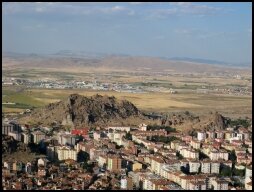 We look around 360 degrees over the city and the entire area surrounding it. There's not much left from the original castle, up close it's obvious that almost everything has been rebuilt a while ago. We do see where the construction materials for the original fortress have been hewn from the rocks and some parts of the old wall are still standing. Before the sun sets we descend to the city, since the hill is not lit at night.
We look around 360 degrees over the city and the entire area surrounding it. There's not much left from the original castle, up close it's obvious that almost everything has been rebuilt a while ago. We do see where the construction materials for the original fortress have been hewn from the rocks and some parts of the old wall are still standing. Before the sun sets we descend to the city, since the hill is not lit at night.
> Further on to Nigde
17-08-2008 We sleep long, as the first bus in the direction we'd like to go only departs at 12.15, excluding the one at the crazy departure time of 6.00 am, so at 12.30 we finally leave Afyon. Again we're surprised about the pleasant Eau de Cologne odor from a bottle, provided by the steward, meant to comprehensively rub your hands with. Turks really have a preference for perfumes. So in the internet cafes they have some sort of Brise-every-thirty-minutes-a-new-smell-machine and in the bus they regularly spray a large quantity of perfume in the aironditioning. Men often smell excessively like aftershave and women like perfume. There's nothing better than a large amount of odor from a bottle or spray here.
The landscapes are flat and boring and sometimes really desertlike. Villages are more and more plain and the houses are often just small huts with a roof of thatch and clay.
By the end of the afternoon we change buses and exactly at 19.30 we get off at the bus station in Nigde. We're glad the bus station of this city is not some kilometers outside the center, so we can just, comfortably, walk to the nearest hotel. This hotel turns out to be the most expensive one of the city, but we decide to splurge today. Turkey is a big country and the distances we cover are large, so it's good to have some luxury every now and then.
> Rock Church of Gümüsler
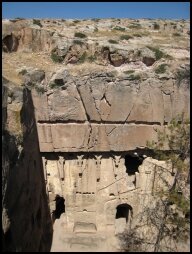 18-08-2008 In the fairly cool morning we visit the rock church of Gümüsler. Remarkable to see that, like the Buddhists did in China, the Christians too have been carving rocks for hours for their religion. Odd how two different populations, living so distant from each other, must have had the same idea. Besides a church with various separate rooms there have also been a complete underground city and a bunch of aboveground dwellings been carved. It's an impressive collection of work which we can enjoy peacefully, since there's no sign of other tourists here... again.
18-08-2008 In the fairly cool morning we visit the rock church of Gümüsler. Remarkable to see that, like the Buddhists did in China, the Christians too have been carving rocks for hours for their religion. Odd how two different populations, living so distant from each other, must have had the same idea. Besides a church with various separate rooms there have also been a complete underground city and a bunch of aboveground dwellings been carved. It's an impressive collection of work which we can enjoy peacefully, since there's no sign of other tourists here... again.When we're back in town we take a look at the mosque and the fort on the hill and an other mosque in the center. Then it gets very hot again and we spend the afternoon in our room.
19-08-2008 On the sly it's more and more the Asia-feeling we get here. "Müze?" (museum) Big smile, "go straight and ... ehm... left", using the right hand to wave enthusiastically. There are no signs of course, or there is, a very old one... pointing to the wrong street. Eventually a man comes along with us to show us the right building. From the outside you could hardly tell this is a museum, but once we're in we're totally surprised by the interesting objects from the Greeks, Romans, Byzantines and Ottomans. Most impressive are 5 very well preserved mummies, where even the eyelashes and leatherlike skin are still there.
> To Göreme
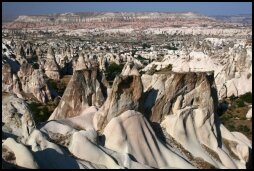 After the visit to the museum we check out in our hotel and take the bus to Göreme, our next destination. After a change and another thirty minutes in the bus we suddenly notice a valley with hundreds of pinnackles ahead, an unforgettable sight. We're there. It's hot and after we got the message the private rooms are full a few times, we decide to try it the Kyrgyz way and find a homestay. They have plenty of rooms available and now we pay only half of the price asked at the full and noisy guesthouses that áre listed in Lonely Planet.
After the visit to the museum we check out in our hotel and take the bus to Göreme, our next destination. After a change and another thirty minutes in the bus we suddenly notice a valley with hundreds of pinnackles ahead, an unforgettable sight. We're there. It's hot and after we got the message the private rooms are full a few times, we decide to try it the Kyrgyz way and find a homestay. They have plenty of rooms available and now we pay only half of the price asked at the full and noisy guesthouses that áre listed in Lonely Planet.We don't do much more today, lazing around is quite nice from time to time.
> Cappadocia
20-08-2008 At 20 past 7 we wake up from a strange sound. there are air balloons flying over our house. The pinnackles must look really great from up in the sky, so every morning dozens of people go up in a balloon. We keep our feet on the ground and walk to Göreme outdoor museum, a collection of churches and monasteries, of which some still have remarkably beautiful frescoes.
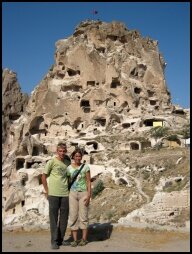 In the afternoon we take a bus to Uçhisar, where, besides a large number of cave houses, they've also hewn a giant castle out of the rocks. The colossus rises above everything else and looks like a giant Swiss cheese, where you can climb to the top by a series of stairs. From up there you can see all of Cappadocia and in the distance we see Göreme. We ascend back to the ground, as we find the castle a bit too tall to get a good view of everything and we walk back to our homestay through the Cappadocian lunar landscape.
In the afternoon we take a bus to Uçhisar, where, besides a large number of cave houses, they've also hewn a giant castle out of the rocks. The colossus rises above everything else and looks like a giant Swiss cheese, where you can climb to the top by a series of stairs. From up there you can see all of Cappadocia and in the distance we see Göreme. We ascend back to the ground, as we find the castle a bit too tall to get a good view of everything and we walk back to our homestay through the Cappadocian lunar landscape.
21-08-2008 It's a day full of plans, but with little activity after all. Well, we should do that more often is what we think.
> Malatya
22-08-2008 We'd like to try and take the early bus to Malatya in Kayseri, but when we get there the next bus only leaves 3 hours later. Bummer! Fortunately there's an internet connection in the bus station, so we don't have to feel bored while waiting.
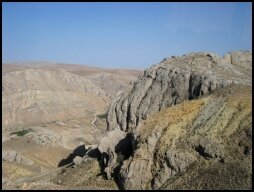 When we finally leave we see the landscapes getting dryer all the time and the hills are becoming more barren and higher. Sometimes we see a blue lake between the mountains. In the early evening we reach Malatyas bus station and immediately we're helped to find the right bus into the city. And also when we get off in the center we'd hardly took our travel guide to orientate, or help is offered from various sides. So, with the help of the friendly Turks, we quickly find a nice and affordable hotel.
When we finally leave we see the landscapes getting dryer all the time and the hills are becoming more barren and higher. Sometimes we see a blue lake between the mountains. In the early evening we reach Malatyas bus station and immediately we're helped to find the right bus into the city. And also when we get off in the center we'd hardly took our travel guide to orientate, or help is offered from various sides. So, with the help of the friendly Turks, we quickly find a nice and affordable hotel.
> Friendly Turks
23-08-2008 Even the bus to the village of Yesilyurt we don't have to find ourselves, a boy takes us there. Another passenger in the bus tells us his father lives in Yesilyurt and he shows us where we'd best get off. We thank him for the invitation for tea, we'd like to go for a walk.
In the village we see a couple of wonderful, old, wooden houses and when we take the next turn we're suddenly in front of a centuries old mosque with a wooden minaret. Th mosque is being restored and the construction workers yell at us to come and drink tea with them. We're glad this is a Muslim country, what would become of us when all these hospitable Turkish people would drink LaoLao or another home-distilled liquor...
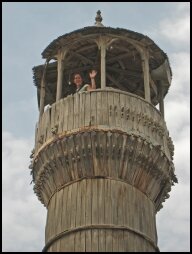 We hear the mosque has been built as early as 1338 and as we can see the last attempt to restore the place is already a while ago. Yvonne takes pictures and one of the men jovially offers her to climb the wooden minaret to take pictures from up there. We worry weather Allah would appreciate such an action, but as the present village elder also approvingly nods she takes the risk and climbs to the top. The thing shakes and jiggles, but offers a wonderful view over the village.
We hear the mosque has been built as early as 1338 and as we can see the last attempt to restore the place is already a while ago. Yvonne takes pictures and one of the men jovially offers her to climb the wooden minaret to take pictures from up there. We worry weather Allah would appreciate such an action, but as the present village elder also approvingly nods she takes the risk and climbs to the top. The thing shakes and jiggles, but offers a wonderful view over the village.When we've said goodbye it doesn't take long before we're offered a ride. We prefer walking to Gündüzbey, the next village, however and enjoy the environment. At the butchery in Gündüzbey we both get a cup of Ayran, salty yoghurt, pushed into our hands and curiously we're watched by the men who sociably sit outside. We haven't walked that far as a lady yells "çay?" at us. We pretend like we haven't heard it, since we're not getting anywhere like this and walk around a bit. On our way back, when passing a house where we've earlier greeted the residents we're invited in. We find it hard to refuse and before we even know what's happening we're drinking selfmade cherry juice and we're offered peaches, grapes and dried apricots from their own garden. Tubby we walk back to the bus stop, without looking up or around in any direction; What if we're asked to eat or drink even more! Soon the bus is there, but at the next stop we can't escape: a man carrying a bag full of handpicked apricots hops in and of course we have to try themn. It's not an option to just take one, so after two apricots each we produce our best smile with our thumbs up.
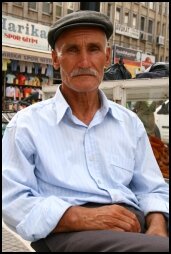 Back in Malatya we first change into another bus, as we'd like to visit the old city with its caravanserai, medressa and famous Ulu mosque. And also this time we don't have to find the place ourselves, an old man walks with us to show us the right way to the mosque. When saying goodbye we're both given a plum and a peach. Yummie!
Back in Malatya we first change into another bus, as we'd like to visit the old city with its caravanserai, medressa and famous Ulu mosque. And also this time we don't have to find the place ourselves, an old man walks with us to show us the right way to the mosque. When saying goodbye we're both given a plum and a peach. Yummie! 
Recently the mosque has been restored and the four mosaics look amazing. The rest of the antiqities aren't all that special and they're also far apart. At 37 degrees we call it a day and we walk back to the place where we got off the bus. When we're waiting for the bus a car with an open window stops: "city?" Uhm... yes. Index finger to the back seat. We hop in and off we go. The guy doesn't speak any English, but he clearly likes it to give us a ride. As a thank you we give hima plum, haha.
> More Info
Also check our Turkey info page, where you can find a lot of information about Turkey and come see our Central Anatolia photos.